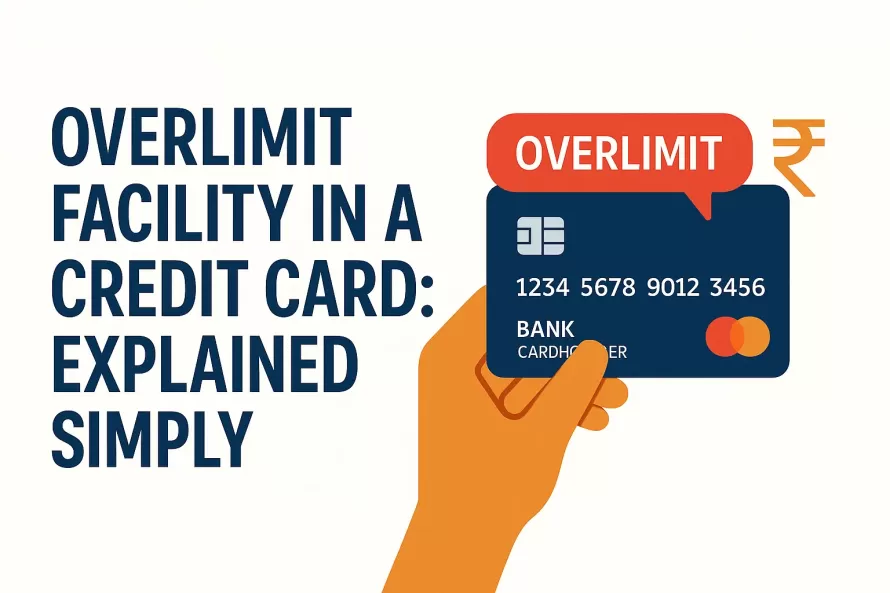What Is Overlimit Facility in a Credit Card? Explained Simply

We all know that credit cards come with a credit limit—a maximum amount you’re allowed to spend. But sometimes, life happens. You might be out shopping, booking flight tickets, or paying a hospital bill when suddenly you realise you’ve already used up your limit. So, what now?
This is where the Overlimit Facility comes into play.
Let’s break it down in the simplest way possible, especially for Indian credit card users.
What Does "Overlimit" Actually Mean?
The term overlimit is pretty straightforward. It means spending more than your approved credit limit on your card.
Let’s say your HDFC credit card has a limit of ₹1,00,000. You’ve already spent ₹99,000, and now you try to make a purchase worth ₹3,000. Normally, this would be declined because you’ve crossed your limit.
But if your card has the overlimit facility active, the bank may still approve that ₹3,000 transaction.
Sounds helpful, right? It definitely can be—but only if used wisely.
How Does the Overlimit Facility Work in India?
Most big Indian banks like SBI, HDFC, ICICI, Axis, and Kotak offer an overlimit feature, but it's not unlimited. Typically, the overlimit is only 5% to 10% of your card limit. For example, if your limit is ₹50,000, you may be allowed to exceed it by ₹2,500 to ₹5,000, depending on your card type and spending habits. Additionally, not all cards have this feature enabled by default—some banks turn it on automatically, while others need you to opt in.
Is There Any Extra Charge?
Yes, and this is important to know.
Using the overlimit facility often comes with an overlimit fee, which varies from bank to bank. Some charge a fixed fee like ₹500, while others may charge a percentage (like 2.5%) of the overlimit amount.
For example, if you go ₹3,000 over your limit and your bank charges 2.5% as a fee, you’ll pay ₹75 extra—plus GST. This fee is added to your next billing cycle and must be paid along with the rest of your dues.
Also, if you don’t repay the full amount, interest charges will apply as usual.
Should You Use the Overlimit Facility?
Only when necessary. Think of it as a backup, not a regular feature. It’s useful during:
- Emergencies (like medical payments)
- Urgent bookings (flights, trains, hotels)
- Situations where declining the payment would cause bigger issues
But using it often is not a good idea. It shows the bank that you’re spending beyond your means. It can also impact your credit score, because crossing your limit increases your credit utilisation ratio, which is a key factor in credit scoring.
How to Check If It’s Active on Your Card?
You can check whether your credit card supports the overlimit facility in a few ways:
- Log in to your mobile banking app
- Visit the credit cards section in internet banking
- Call customer care (toll-free numbers are usually printed on the back of your card)
- Visit your nearest branch
If you don’t want this feature, most banks also allow you to disable it for more control.
Overlimit Facility: Pros and Cons
Pros
- Helps in emergencies: If you suddenly need money for things like medical bills or travel, the overlimit feature allows your card to work even if you go slightly over the limit.
- May help your credit score: If you manage it well, it can lower your credit usage percentage, which may improve your credit score.
- Extra flexibility: It gives you a bit more spending power when you're in a tight spot financially.
Cons
- Extra charges: Going over your limit usually means extra fees or interest, which can cost you more in the long run.
- Higher debt risk: Relying on this feature often can lead to more debt than you can easily handle.
- Credit score impact: Using it too often or not repaying on time can hurt your credit score and affect future borrowing.
What’s the Smart Way to Use It?
If you do use the overlimit feature, here are a few tips to stay safe:
- Don’t use it unless it’s absolutely necessary
- Always pay the full amount, including the overlimit charges, in the next bill
- Track your spending so you don’t cross the limit by mistake
- Set alerts or notifications for when you're close to your limit
- If you’re crossing your limit often, request a credit limit increase from the bank
Final Thoughts
The overlimit facility helps when you spend a bit more than your card limit—it lets the payment go through. But it’s not free; there are extra charges. Use it only when needed, and don’t rely on it often, as it can hurt your credit score. If you find yourself using it a lot, consider cutting back on spending or asking your bank to increase your limit.




Leave a Reply